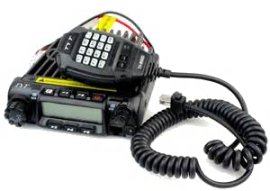TYT TH-9000D 1.25M Transceiver
Tytera TH-9000D Mono Band Transceiver
65 Watt Heavy Duty Two Way VHF Mobile Transceiver with ctcss/dcs (PL & DPL).
200 Alphanumeric Channels, Full Keypad Microphone. Cool-Blue Display Backlight. Includes mounting bracket & fused power Cable. Features 3 Selectable Power levels, DTMF, Keypad lock, Scan modes & more
front panel controls:
short press long press ------------------------------ ------------------------------ [F ] select memory channel for save [P1] clone [P2] open squelch "monitor" display operating voltage toggle [x ] power [P3] VFO/memory scan [P4] tune step offset -,+,none, and freq [P5] tone squelch (disable, tone, tsql, dcs) chan memory ?
hand mic:
- adjust transmit power: press [FUNC] then [0] to toggle though three transmit power levels.
Review
This is a solid built and rugged transceiver. It has a Part 90 feel to it. There is even a menu option to disable the VFO for channel restricted use. It is powerful, at 65w output on high. However, it will get very hot when operating on high power, or long QSOs on medium power. The manufacture should have equipped it with a rear cooling fan, but they did not. Some wise ham operators have added a cooling fan on the back of the unit using a PC CPU cooling fan or something similar, especially when used as a base station.
The two biggest criticisms of the TYT TH-9000D are the lack of a cooling fan, and even more significantly, the painfully non-intuitive programming. This thing is a #@!$ to program from the unit! It is probably a lot easier to program with software. The manual is inaccurate and nearly useless for programming. We have taken the time to document the most important programming procedures here and verified them to be correct.
Some units have been prone to internal speaker failure due to cold solder joint or related issue. This is an easy fix.
Out of the box the unit goes below and above the legal 1.25 ham radio band. Take care in not transmitting out of band.
Usage
This is a difficult radio. This quick guide should help to program directly.
Frequency Offset:
- LONG PRESS [P4] one time - you will see the offset frequency amount. Set it to 1.600 for the standard.
- LONG PRESS [P4] again - the second time you long press you toggle between -,+, and none
- SHORT PRESS [P4] while in the offset freq or toggle to save
PL/CTCSS Tone:
- SHORT PRESS [P5] one time - set the tone frequency
- SHORT PRESS [P5] again - toggle tone, tone sq, dcs, and off. You will see a T on the screen of tone is enabled.
- SHORT PRESS [P4] to save. Notice P4 and not P5. There may be other keys that also save.
Channel / VFO Toggle:
- note: There must be at least one channel with saved data to be able to enter channel mode
- From the UNIT you can press [P3] to toggle between VFO and Channel mode
- From the MIC you can press [VFO] to toggle between VFO and Channel mode
Save to Memory Channel:
- Select the channel, freq, and offset
- SHORT PRESS [F] and turn the vfo knob to desired channel number
- SHORT PRESS [P3] to save to channel memory
Toggle TX Power L/M/H:
- From the UNIT you can press [F] and then [P1] but not at the same time - toggles TX power
- From the MIC you can press [FUNC] and then [0] - toggles TX power
Help
Stuck in professional (channel only) mode:
- Also referred to as Part 90 mode. Long press [F] until shows menu #26 and change it to NM or FR. Just don't be in CH. When item #26 is set to CH then the radio is locked in professional mode. To save press [P5].
Stuck in LOCK mode. LOCK symbol in top right:
- Press [F] + [P5] to toggle between lock mode ON/OFF.
